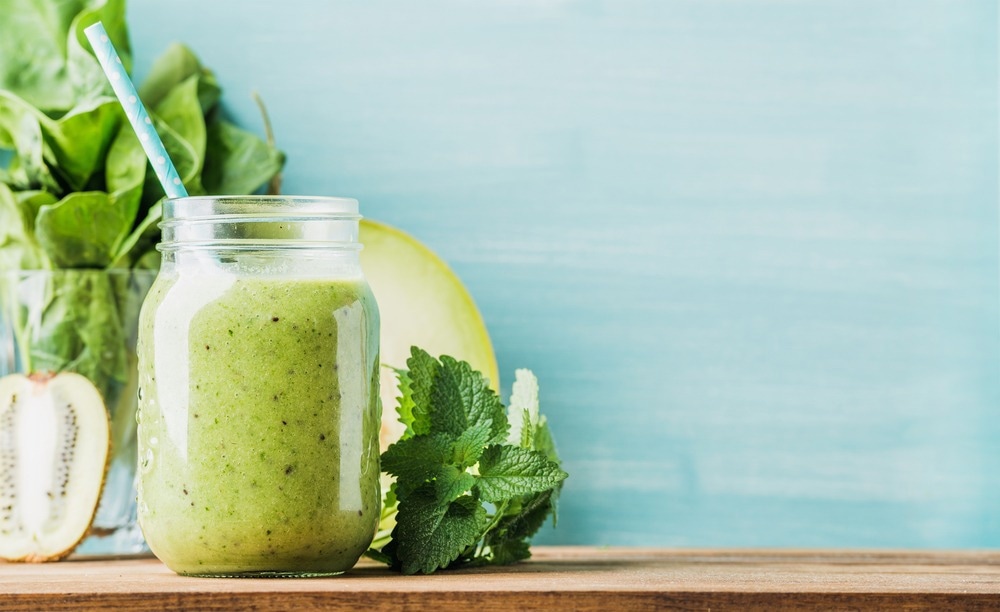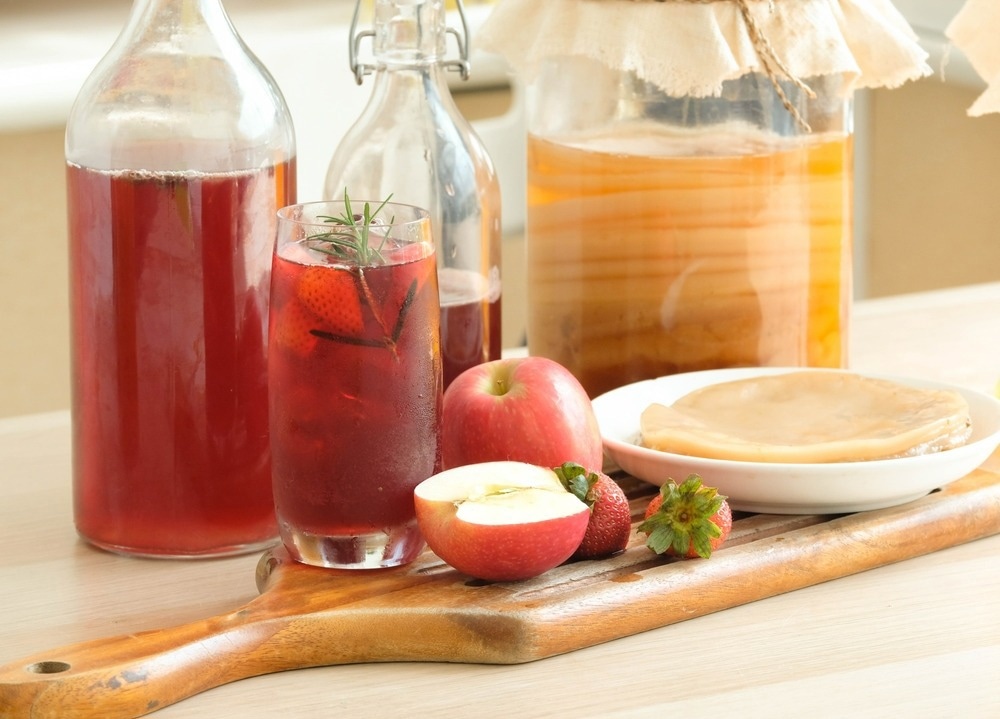Functional beverages are among the fastest-growing functional food segments. This is partly due to their perceived benefits for overall health and chronic disease prevention.

Image Credit: Foxys Forest Manufacture/Shutterstock.com
Introduction to functional beverages
A functional beverage can be defined as “any non-alcoholic drink that provides additional health benefits due to the inclusion of any bioactive component from a plant, animal, marine or microorganism source.”1 In general, they are classified as dairy-based, plant-based, and sports or energy drinks.
Functional beverages form one part of the broader category of functional drinks, which comprises any drink with a specific function beyond hydrating the individual and is intended, without added ingredients, to support health and wellness.
The raw materials used included kinds of milk made from various plant products (soy, coconut, rice, oat, and nut milks), fruit juices, dairy products, herbal teas, and synbiotics. In particular, fruits and vegetables lend great value to functional beverages as they contribute a lot of water, along with major macronutrients, vitamins, and minerals.
Consumer interest in these drinks is driven by their growing awareness of the dietary impact on health, hectic lifestyles that make healthy eating more difficult, and the increasing availability of high-convenience functional foods. In addition, interest in alternative and complementary medicine is high, especially to prevent and treat chronic diseases.1
Key ingredients and their health benefits
Functional beverages contain bioactive ingredients like phenolic compounds, vitamins and minerals, amino acids, unsaturated fatty acids, and peptides, all of which come from probiotic microbes, plants, or animals.1 These are reported to be of benefit in reducing cancer rates and preventing cardiovascular disease and diabetes, with antioxidant and anti-inflammatory activity. In addition, they improve gut health, immune function, and cognitive health.7
Functional beverages and digestive health
Fermented beverages form the fastest-growing segment of the US food market. They are inexpensive, preserve the nutritional profile and sensory attributes (color, taste, and smell) of the beverage, and promise impressive health benefits. 4
These claims are based mostly on their probiotic and prebiotic content. Probiotics include bacteria, molds, and yeasts, all living organisms that enhance the host’s health if ingested in adequate quantities. Prebiotics are fermented selective substances that cause targeted changes in the gut microflora to enhance its composition and activity. 4
A combination of prebiotics and postbiotics is called a synbiotic and is used for its positive effect on gut health, which improves overall host health. This is via increased enzyme activity, better gut barrier function, the production of antimicrobial substances, competitive inhibition of pathogenic bacteria, changes in pH, immunomodulatory function, and the suppression of precancerous gut changes. 4
Many probiotic-rich beverages are dairy-based, such as yogurt, goat’s milk, or kefir. However, lactose intolerance and milk protein allergy may reduce the appeal of dairy-based probiotic drinks.4 Nondairy probiotic beverages include fermented fruit juices and kefir-like fermented drinks from flaxseed oilcake, as well as probiotic-fermented fruit pulp and pomace.

Image Credit: premkamon/Shutterstock.com
Probiotics may cause adverse effects such as their crossing into the bloodstream or tissues, carrying virulence factors or antibiotic-resistant plasmids, or inhibiting colonization of the gut with normal microflora. These are avoided with postbiotics, the health-enhancing metabolic byproducts produced during fermentation by probiotics. Examples include short-chain fatty acids, peptides, and organic acids.4
Energy and hydration solutions
Energy drinks typically contain caffeine along with taurine, B vitamins, sugars, and other substances. They are marketed to improve acute aerobic and mental performance, mostly because of the caffeine and sugar content.
However, the composition of energy drinks varies, and each ingredient has not been studied, especially their interactions with other nutrients. Some energy drinks may cause weight gain with chronic use, as well as metabolic and cardiovascular sequelae.
Some functional energy drinks use their relatively low sugar content and ‘clean’ caffeine as selling points.
However, these drinks are not recommended in adolescents and women who are either pregnant, lactating, or preconceptional. Moreover, they may not be safe for people with chronic diseases or those already ingesting significant amounts of caffeine.
Challenges and considerations
At present, researchers are looking at formulating more stable versions of functional beverages using encapsulation, emulsification, homogenization, and the like.1 However, the effects of such changes on bioavailability, safety, and sustainability must be closely monitored.
In addition, waste products like pomace may be used as natural sources of functional fruit beverages, given the proper processing technique to extract the maximal amount of phytochemicals and antioxidants.
The use of stevia could help reduce or avoid the use of simple sugars, thus helping to reduce overall caloric intake and perhaps enhance antioxidant activity by increasing its ability to absorb oxygen radicals.3
Functional beverages are not panaceas but may work in tandem with other lifestyle measures to improve health, including overall diet quality, exercise, stress management, and sleep hygiene. Unfortunately, functional beverage marketing focuses on increasing their consumption rate irrespective of the need.
Probiotics come in a wide variety of organisms, dosages, use patterns, levels of active ingredients, and duration of use. The resulting lack of standardization has made it difficult to pin down the effects of these functional foods on health. 4
Food labeling is a crucial point issue, and regulation of functional beverages is essential to prevent misleading or false claims or information.2 The sustainability and authenticity of the beverage must be verifiable, along with correct labeling.
Consumer trends and future outlook
Though functional beverages are considered fluids, newer products stretch the definition by being designed to swill out the mouth, such as those containing menthol. Commercial fruit-based beverages are another emerging area. They are prepared from juice that is liquefied by enzymes like pectinase, making them ready to drink.3 Novel sources of natural functional beverages are being explored, as well as nanoscale formulations.4
Conclusion
Functional beverages represent a rapidly growing field of marketing and research. The search for new natural sources of functional beverages, better standardization, and newer formulations continues.
Functional beverages represent a convenient way to incorporate healthy nutrients into the diet. However, further research is required to establish the toxic levels of various constituents, the long-term effects of chronic consumption, and actual clinical benefits in terms of reduced disease incidence in humans.6
References
- Gupta, A. et al. (2023). Trends in functional beverages: Functional ingredients, processing technologies, stability, health benefits, and consumer perspective. Food Research International. https://doi.org/10.1016/j.foodres.2023.113046. https://www.sciencedirect.com/science/article/abs/pii/S0963996923005914.
- Orru, S. et al. (2018). Role of Functional Beverages on Sport Performance and Recovery. Nutrients. doi: 10.3390/nu10101470. https://www.ncbi.nlm.nih.gov/pmc/articles/PMC6213308/.
- Naumovski, N. et al. (2020). Functional Beverages, from Idea to Functionality. Beverages. doi: https://doi.org/10.3390/beverages6040071. https://www.mdpi.com/2306-5710/6/4/71
- Nazhand, A. et al. (2020). Ready to use therapeutical beverages: focus on functional beverages containing probiotics, prebiotics and synbiotics. Beverages. doi: https://doi.org/10.3390/beverages6020026. https://www.mdpi.com/2306-5710/6/2/26.
- Jagim, A. R. et al. (2023). International society of sports nutrition position stand: energy drinks and energy shots. Journal of the International Society of Sports Nutrition. doi: 10.1080/15502783.2023.2171314. https://pubmed.ncbi.nlm.nih.gov/36862943/.
- Carvalho, F. et al. (2023). Natural functional beverages as an approach to manage diabetes. International Journal of Molecular Sciences. doi: https://doi.org/10.3390/ijms242316977. https://www.mdpi.com/1422-0067/24/23/16977.
- Samtiya, M. et al. (2021). Potential Health Benefits of Plant Food-Derived Bioactive Components: An Overview. Foods. doi: https://doi.org/10.3390%2Ffoods10040839. https://www.ncbi.nlm.nih.gov/pmc/articles/PMC8068854/.
Further Reading